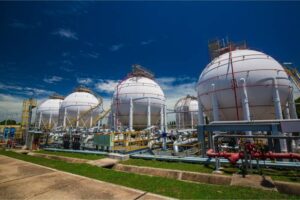Natural Gas Market Insights: Navigating Current Trends
As we delve into the world of natural gas trading this February, we’re experiencing a market that’s showing signs of both resilience and caution. In the midst of colder weather earlier this month, we saw a significant drawdown in inventories. However, as current data comes in, it’s becoming apparent that we are facing weaker overall consumption trends. At Extreme Investor Network, we believe in not just reporting the news but helping our readers understand what these trends mean for their investment strategies.
Current Demand Trends: A Mixed Bag
Recent figures indicate that Lower-48 state gas demand dropped to 80.2 Bcf/day as of last Friday, marking a 10.3% decline from the previous year. This downward trend raises a pertinent question for traders: without a late-season cold snap, what bullish catalysts can we realistically expect in the near future? As we analyze this dynamic, it’s crucial to remain informed and prepared for sudden market shifts.
The Impact of Supply and LNG Demand on Pricing
Production seems robust, with Lower-48 dry gas output clocking in at 107.8 Bcf/day, which is a 2.8% increase over last year. Moreover, liquefied natural gas (LNG) exports are providing some semblance of stability to prices, with flows to U.S. export facilities reaching 15.6 Bcf/day, signaling a 2.1% week-over-week uptick.
A significant change on the regulatory front emerged recently: the Trump administration’s decision to lift the Biden-era moratorium on new LNG export approvals. Bloomberg reports that progress is underway on the Commonwealth LNG facility in Louisiana, which could have broader implications for U.S. natural gas demand in the coming years. However, for the immediate landscape, it’s weather patterns and storage levels that are currently steering price movements.
Storage Data: The Numbers that Matter
The latest EIA report indicated a 261 Bcf withdrawal for the week ending February 21, slightly below the anticipated 271 Bcf, but notably higher than the five-year average of just 141 Bcf. Presently, total working gas in storage is 11.5% below the five-year average, indicating that supplies are tighter than they have been historically.
While these storage levels appear supportive of prices, the absence of immediate demand for natural gas keeps the market in a state of cautious optimism. With inventories overshadowing past records, traders remain hesitant to commit to aggressive buying tactics in the absence of a substantial weather-driven demand surge.
Market Outlook: A Bearish Sentiment Persists
As we align our insights with market behavior, it’s apparent that a bearish bias continues to dominate. Traders are well aware that unless we observe a significant uptick in demand spurred by weather events or production disruptions, we’re left with limited bullish catalysts.
At the Extreme Investor Network, our commitment goes beyond merely analyzing trends; we empower our readers with the knowledge to navigate these uncertain waters confidently. Understanding market dynamics isn’t just about observing numbers—it’s about applying that intelligence to make informed decisions.
As we navigate through February and position ourselves for the upcoming months, keep a close eye on market indicators. Whether you’re a seasoned investor or just starting, these insights are essential to maintaining a competitive edge in the energy sector. Join us at Extreme Investor Network, where we decode complex market nuances and help you harness the power of informed investing.

